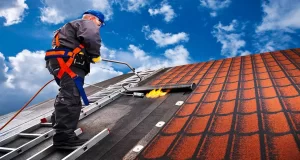The Evolution of Roofing Materials: A Historical Perspective
The roof above our heads has seen an incredible transformation over the years. Let’s take a fascinating journey through the evolution of roofing materials from ancient times to today:
- Thatch & Mud: Used by ancient civilizations, these materials were abundant and easy to source. Thatched roofs, created from straw or reeds, were common in European villages, while in drier regions, mud was used.
- Clay Tiles: Ancient Greeks and Chinese civilizations started using clay tiles due to their durability and aesthetic appeal. These tiles became symbols of wealth and luxury.
- Wood Shingles: Around the Middle Ages, wood, especially cedar, became a popular roofing material in Europe and North America due to its abundance.
- Slate and Stone: These materials were known for their longevity and were often seen adorning churches, castles, and mansions.
- Metal: In the 19th century, metals like copper, lead, and tin became desirable roofing materials, especially for their ability to withstand harsh weather conditions.
- Asphalt Shingles: Introduced in the 20th century, these became one of the most common roofing materials in the USA due to their affordability and versatility.
- Modern Innovations: Today, we have a myriad of options ranging from solar tiles, green roofs to advanced metal alloys and composites.
The shift in roofing materials over time reflects our technological advancements, cultural preferences, and evolving understanding of sustainability. At Gridiron Roofing, we honor this history by providing roofing solutions that combine the best of tradition with modern innovation.









